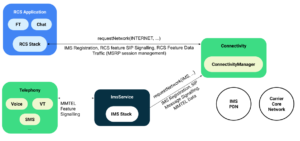Whenever a new innovation hits a market, regardless of how useful it may be, there are those who are averse to change. Given what Diffusion of Innovation Theory teaches us, this makes sense. Innovators and early adopters are quick to take to new ideas, but the majority of us need more evidence before we’re willing to take the risk. Invariably, we look to experts and influencers to take the lead and look to learn from their experiences before putting our own time or money on the line. In the world of enterprise WAN, we have seen this play out with SD-WAN over the last few years. However, with industry experts like Gartner touting the benefits of SD-WAN, we have reached the point where SD-WAN is crossing the chasm from the early adopter stage.
SD-WAN is no longer just a promising new technology, when it is properly executed, it is a game changer for the enterprise WAN. This isn’t to say that SD-WAN is a magic wand that you can use to make all your challenges disappear overnight, proper planning and decision-making are still vitally important. Further, there are a number of issues in the SD-WAN market like including market confusion, market fragmentation, feature limitations with some solutions, and vendor lock-in.
In this piece, we’ll explore the general benefits of SD-WAN, the issues facing the SD-WAN market, and explain how SDWaaS (SD-WAN as a Service) can serve as a holistic enterprise WAN solution.
Why SD-WAN?
What exactly makes SD-WAN such a compelling solution for enterprises? To answer this question, it is important to understand the legacy WAN solutions it is often replacing these days, particularly MPLS (Multiprotocol Label Switching), and the routing challenges facing the modern WAN. MPLS has proven to be quite effective at solving the problem of reliably connecting two locations. This made it quite useful in the early 2000s and helped it become “the” WAN solution for some time. However, as cloud and mobile computing surged in popularity, a number of flaws (beyond the already well-known high bandwidth costs) in the MPLS paradigm became apparent. MPLS simply isn’t flexible enough to meet the demands of mobile and cloud users efficiently. This makes it a sub-optimal WAN solution for modern businesses.
SD-WAN not only helped reduce bandwidth costs by enabling the enterprise to leverage affordable Internet bandwidth, it added agility and even enhanced availability thanks to the ability to leverage multiple transport methods (e.g. xDSL, 4G LTE, cable, etc.). With SD-WAN, enterprises were able to save money and implement a solution that meets the challenges of a modern WAN. In a nutshell, this is what led to its impressive growth in popularity over the last 5 years.
Confusion in the market
While the benefits of SD-WAN are easy enough to understand, actually navigating the market and finding the right solution for you can be a confusing endeavor. There are a myriad of players, and with the technology being relatively young, understanding what makes sense and who is offering the features and services you need can be difficult. For this reason, it is important for you to be able to ask the right questions of potential SD-WAN vendors. Referring back to the Gartner piece mentioned earlier, they recommend reviewing criteria like:
• Scale & Architecture
• Management & Orchestration
• Visibility and Security
From there, you can probe further and learn more about what a vendor can offer you. This helps you avoid vendor lock-in with a provider that can’t meet your needs, which is particularly risky in a market that is growing and changing as fast as the enterprise WAN market is.
The SDWaaS difference
Possibly the most compelling and complete SD-WAN offerings on the market come in the form of cloud-based SDWaaS. Not only does SDWaaS offer the “standard” SD-WAN benefits agility and the ability to use economical bandwidth, it helps make a WAN more scalable, robust, and secure.
This is because premium SDWaaS providers offer an SLA-backed, robust global backbone that is supported by multiple Tier-1 ISPs (Internet Service Providers). This private backbone includes multiple Points of Presence (PoPs) across the globe that help make SDWaaS more than just a way to leverage multiple Internet transports. Further, self-healing and failover features make SDWaaS resilient enough to meet the demands of uptime conscious enterprises.
Management with SDWaaS is much simpler and easy to maintain than legacy MPLS solutions and many “do it yourself” SD-WAN configurations. Locations that may have taken months to provision using MPLS, can be completed in a few days/weeks with SDWaaS.
Finally, premium SDWaaS has a full security stack “baked-in” to the solution. Not only does this enhance security, it minimizes complexity. By making security inherent to the WAN, there is significantly less complexity involved in maintaining and scaling a secure WAN infrastructure.
SD-WAN is here to stay, and SDWaaS is a robust & enterprise-ready implementation
It’s clear that anyone seriously evaluating enterprise WAN solutions today needs to seriously consider SD-WAN as a possibility. In what seems to be the majority of use-cases these days, SD-WAN the benefits of SD-WAN outstrip the alternatives by a wide margin. However, with a plethora of solutions, it can be difficult for organizations to drill down and select SD-WAN solutions that maximize the upside while also effectively addressing those key points of scale, management, and security Gartner mentioned. In that regard, SDWaaS has emerged as a front-runner, offering a scalable, easy to manage, and secure global SD-WAN infrastructure enterprises can rely on.





More Stories
dji pocket 3 vs. Competitors: Which Gaming Console Reigns Supreme.
What Are the Most Common Sources of Waste in the Business World?
6 Tips for Designing the Perfect eCommerce Website